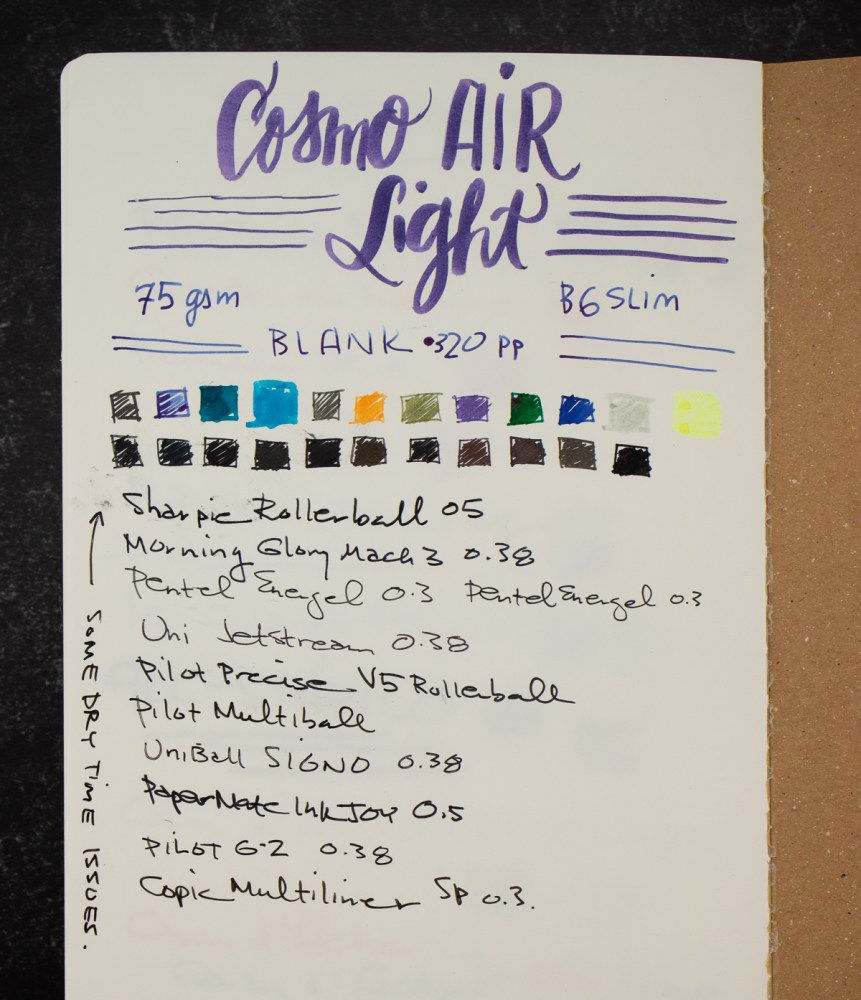I realize I am about two year late to the joys (and sorrows ) of Cosmo Air Light (CAL) but I decided that since the paper was going away, I should be an informed blogger and experience the paper while I still had the opportunity. Also, I wanted be able to find and recommend other products that might be similar.
About the notebook:
The CAL notebook I got came from an Etsy seller named Danika58. The notebook features kraft cardstock covers with a black binding tape around the spine. There are 10- stitched signatures in the notebook and the soft tape-bound spine means the book lays flat easily. Because the cover stock is not as heavyweight as a traditional hardback notebook, this is the perfect notebook to use with a cover. The cardstock cover though heavy enough to survive on its own. There is NO branding on the notebooks at all so if you love it, be sure to remember where you purchased it because a year from now, you will not have any clues where it came from. Of course, a year from now, there probably won’t be anymore Cosmos Air Light paper anyway so its probably a non-issue.

Understanding the B6 Slim Size:

I have mentioned several times this year how much I am loving the B6 size so I thought I’d try a B6 Slim (approx. 7 x 4.25″) which is approx. 1″ narrower than the standard B6 size. As far as I can tell, the B6 Slim size relates back to specific Midori notebook sizes (Midori: also responsible for the A5 Slim sizing for the Traveler’s Notebooks). The Jibun Techo calendar/planners feature a size described as B6 Slim but it looks to be a little bit larger. Ah, the joys of “-ish” sizing.

Pictured above and below is my B6 Bassy & Co leather cover and the CAL B6 Slim notebook. I included a side view of the B6 Slim on top of my current Stalogy B6 to make it more apparent the width difference. The B6 Slim is going to be too narrow to work effectively in a standard B6 cover. Note to self.

Writing & Pen Tests:

Jesi did a very thorough review of the Cosmo Air Light paper from Musubi awhile back and has continued to use the CAL paper as part of her ink reviews so I took a slightly less thorough approach to my pen tests and included (gasp!) pencils in the mix.

The CAL for pencils is a little hard. I recommend a slightly softer pencil, HB or softer and colored pencils with a softer core unless you want a really fine, light line. I prefer to not have to stab my paper to get the pigment onto the paper but everyone has their own preferences.

For my fountain pen tests, I used some of my everyday carry pens and had good results overall. Inks sheened or shaded as expected and lines were crisp.

There was some show through on the back side of the sheet but it’s very minimal. I could easily use the front and back of the pages.

Additional tests included the random assortment of pens I keep in a zipper pouch at work for meetings — a range of gel, rollerball, and felt tip pens for writing on copies, 3×5 notecards and post-it notes in meetings, brainstorms and working sessions. As mentioned earlier, hard pencils like my vintage Verithin was a bit lighter than on a softer, more textured paper. But its’ a pretty hard pencil. Normally, I prefer the Caran d’Ache red/blue pencil for it’s soft, creamy core.
I can see the appeal of the Cosmo Air Light paper. Like all fountain pen fanatics, I can see myself hoarding a few of these notebooks for posterity but now that I have used CAL, I feel better recommending the Regalia paper from Endless as a solid alternative. With the exception of multi-chromatic inks, the two stocks performed similarly under regular usage.
DISCLAIMER: Some items in this review were purchased with funds from our amazing Patrons. You can help support this blog by joining our Patreon. Please see the About page for more details.

































